|
When
I first arrived at art school, many years ago, I had little
knowledge of the many movements that were to become the
backbone of our art history classes. For reasons I cannot
recall, the only one I thought I knew anything about was
Surrealism, and the only painter whose work I was familiar with was Salvador
Dali. I wasn't alone here. Discovering the wonders of
Impressionism, Futurism, the Bauhaus and Dada et al proved
an unexpected joy, but when the time finally arrived for
us to study the Surrealist movement, the class let forth
a murmur of excitement, which was countered somewhat by
our lecturer's audibly weary sigh. This, it turned out,
happened every year, and each time he would have to point
out that there was a lot more to surrealism than Senior
Dali (see the documentary Les Chimères de
Svankmajer below for more on this) and that in
his view Dali wasn't a proper surrealist anyway. We thus
entered this particular phase of the course a little deflated,
but two weeks later I was flying. By then I'd discovered
the paintings of Giorgio de Chirico and Rene Magritte, the writings
of Andre Breton and the genius of Luis Buñuel
via Un Chien
Andalou, his film collaboration with that improper surrealist Salvador
Dali. That two weeks had helped bring into
focus the hazy beauty of the subconscious and the dream
world, or at least the artistic interpretation of it. It
was here that my lifelong love affair with surrealist cinema
began.
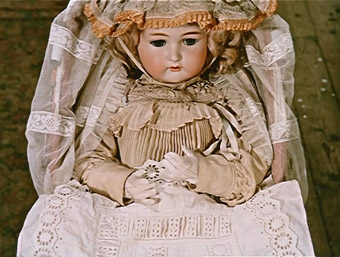
It
took me a surprisingly long time to discover my first surrealist-influenced
animated short, and in the subsequent years I came to appreciate
just how perfectly suited this art movement
and this particular medium were to each other. A painting or a sculpture
may be able to capture the essence of a dream, but the moving
image can, in the right hands, evoke the experience. I've
watched a lot of animated shorts that have been at least partly
shaped by the principals of surrealism, but few left me
as gobsmacked as the first one I saw, a film that single-handedly
ignited my collector's fascination with the genre. The film
in question was Dimensions of Dialogue,
the director Jan Svankmajer. If you've seen it then hopefully you'll know
what I mean. If you haven't, then boy are you in for a treat.
But there's more. Much more.
During
the course of his career, the Prague-based Svankmajer has
to date directed a total of twenty-six short films and five features
and has steadily built a reputation as one of the world's
most visionary and respected animators. Like those other
modern masters of animated surrealism, the Quay Brothers,
Svankmajer is a superb technician with a fondness for traditional
stop motion techniques. Signature elements of his films
include lightning fast montages, a distinctive use of clay
animation and 'animated' live action, an inventive incorporation
of found objects, and a fascination with structural decay
and haunted memories of childhood. A distinctive element
of Svankmajer's surrealism is its sometimes dark sense of
humour, from the frustrations piled on the unfortunate occupant
of The Flat and the silent cinema influence
on the otherwise pessimistic A Quiet Week in the
House, to the faux-documentary form of The
Castle of Otranto and the bizarre violence dished
out by the football players to each other in Virile
Games. He comes close to all-out surrealist comedy
in Darkness-Light-Darkness, in which a
body in the process of gradual self-assembly experiments
with a number of curious combinations before getting it
right, the thunderous arrival at the door of excited genitalia throwing the rest of the parts into fearful pandemonium.
There's
a paradox at the core of all surrealist art in which the
deliberately random becomes the subject of analysis and
debate, a search for hidden meaning in a piece that is supposed
to have none. Buñuel and Dali's famous claim of Un
Chien Andalou that "Nothing in this film symbolises
anything" has failed to prevent almost 90 years of
essays attempting to psychoanalyse its images and structure,
but given that this is the imagery of dreams and that dreams
themselves have long since been the subject of psychoanalytical interpretation,
this is both understandable and valid. The same is inevitably
true of Svankmajer's work, although he is more deliberately
up front in some of his symbolism and subtext. There's a
political undercurrent to many of the films that is specific
to its time and place, his sly digs at his country's Communist years
giving way to the all-out assault of the post-Velvet Revolution in The Death of Stalinism in Bohemia. Ironically,
when his work did fall foul of the Communist authorities
it was often the result of their misreading of the film's
artistic elements.
Equally
and often more pronounced are the elements inspired by the
director's personal concerns, fascinations and fears: the
inability of individuals to effectively communicate that
is central to Dimensions of Dialogue; the
sense of false hope that dominates A Quiet Week
in the House; the degeneration of sport into violence
of Virile Games; the rampant consumerism
of Food; the childhood terrors of Down
to the Cellar. This last one in particular Svankmajer
admits is strongly autobiographical – in one of the supporting
documentaries in this DVD set, he recalls that the experience
of being sent down to the cellar of his apartment block as a boy
to collect coal or potatoes was so terrifying that he considered
running away rather than having to repeat it.
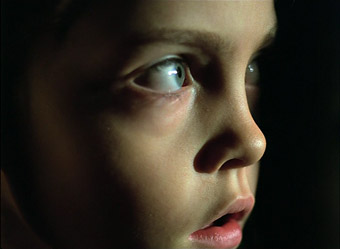
Svankmajer's
films exemplify why the animated short needs to
be taken seriously as the premier modern art form, combining
as it does the disciplines of painting, sculpture, collage,
photography and experimental filmmaking to emotional as
well as intellectual effect. As a collection, this BFI DVD
set not only provides convincing evidence to support this
proposal, but also usefully illustrates the extraordinary
variety and scope of this unique filmmaker's oeuvre, making a mockery
of the complaint by one IMDb contributor that Svankmajer
has not progressed since 1971. This is, quite frankly, an
astonishing body of work whose status can be measured by
the fact that you end up judging the films not on how good
or bad they are, but on their relative greatness in relation
to each other.
The
short films are collected on the first two discs of this
set – the third disc is covered in the Extra Features section.
| the films – disc 1: the early shorts 1964-72 |
|
The
Last Trick / Poslední trik pana Schwarcewalldea a
pana Edgara [1964] (11:19)
Svankmajer's first film as director, but you wouldn't know
it from the confidence of the execution. Two doll-headed
magicians take it in turns to perform tricks for the amusement
of an unseen audience and the admiration of each other, the
congratulatory handshake that concludes each demonstration
becoming increasingly harder to break free from. Blending
live action with stop motion, it's recognisably Svankmajer
from the start and a pointer to things to come, from its
production design and lightning fast montage editing to
the degeneration into one-on-one conflict that ends in bodily
dismemberment. Even the opening credits are playfully inventive
in a way that has been borrowed from many times since.
J.S.
Bach – Fantasy in G Minor / Johann Sebastian Bach: Fantasia
G-moll [1965] (9:26)
Music and imagery are stunningly entwined in this ravishing
toccata of decay, as the Bach organ piece of the title is
visualised through images of crumbling walls, decaying doors
and shattered windows, beautifully photographed in scope
framed monochrome and brought to life with rapid camera
movements and animated transformation of their surface materials.
A simple idea, immaculately realised – in the final rapid
corridor tracks the camera seems to become the music.
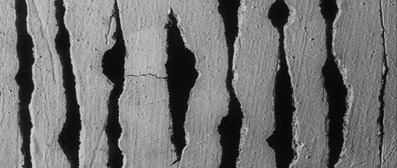
A
Game With Stones / Hra s kameny [1965] (8:36)
An honest title for a playful animated experiment with variously
shaped and coloured stones, which are spewed from a clock
once an hour and engage in a series of dances to the tinkling
of the clock's own in-built music box. An enjoyable piece
that feels more like an early film than the two that precede
it, the sort of project budding animators test out their
skills on. One sequence involving small stones used to make
up human faces clearly anticipates the later Dimensions
of Dialogue.
Punch
and Judy / Rakvickarna [1966] (9:54)
One of the first Svankmajer films I saw (under its alternative
title of The Coffin Factory) and one of
his few early films to have even a semblance of a linear
story. Punch and Judy expands on the grotesquery
and violence of the character of Punch (I've never understood
why kids aren't completely freaked out by this horrible
creature) and his destructive conflict with his partner,
something that Svankmajer seems to have enjoyed exploring.
Et
Cetera [1966] (6:58)
In visually arresting shadow puppetry style, Svankmajer
toys with notions of freedom, obedience and capitulation,
the shifting and corrupting nature of power, and conflicting
desires for security and independence, all particularly
relevant to the time and place in which the film was made.
Historia
Naturae, Suita [1967] (8:38)
A brilliantly edited celebration of the beauty and complexity
of various animal species, which man, it is suggested, collects,
imprisons, preserves and consumes. One of Svankmajer's most
overt early political statements.
The
Garden / Zahrada [1968] (16:09)
Svankmajer confirms his surrealist credentials with this
live action story of reunited old friends, one of whom accompanies
the other to his quiet house in the country to find it surrounded
by a 'living fence', an unbroken ring of people with linked
hands and stare-ahead faces. A genuinely dream-like concept
with inescapable political overtones – many of those in
the fence are dressed in the clothing of service occupations,
workers in servitude to a landowner master, who cares nothing
for their welfare and demands their unquestioning obedience.
There is a dark inevitability to the ending, but that doesn't
make it any the less chilling, and the visiting Frank's habit
of nervously combing his hair is later used to subtly comment
on the nature of authority within a system based on power and
class.
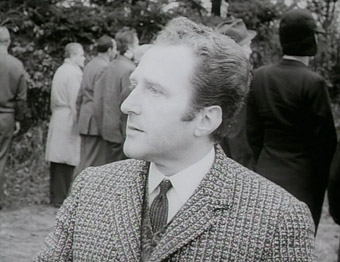
The
Flat / Byt [1968] (12:34)
A blackly comic surrealist nightmare that leads a young
man into a room whose contents all disobey real world logic
– water escapes from a gas stove, stones pour from a tap,
a crooked picture cannot be adjusted without the one above
it shifting, and a swinging light bulb punches a hole in
the wall from which a wooden fist emerges to assault
the curious. An attempt to eat is similarly frustrated by
a soup spoon riddled with holes, a fork that bends out of
shape, a beer glass that reduces to thimble size when raised
to the lips, and an egg that falls through the table and
is swallowed by a wall when thrown at it. A direct link
with the surrealist movement is provided by a man who emerges
from a wardrobe dressed in a Magritte-style bowler hat and
a mirror that displays the back of the head rather than the
face looking into it, recalling both Magritte's Not
to be Reproduced (1937) and Dali's My Naked Wife
Watching Her Body (1945).
Picnic
with Weissmann / Picknick mit Weissmann [1968]
(10:41)
In a woodland clearing, a man's possessions and furniture
enjoy a quiet few hours without him. 78rpm records play,
a chess board engages in a game with itself, three chairs
and a dresser play football, a plate camera takes portraits,
and a pair of pyjamas lounge on a bed and eat plums. Meanwhile,
a shovel busies itself digging a large, rectangular hole.
The surrealism of dislocating objects from their normal
environment is explored to seemingly playful effect, but
there's a dark twist to the tale that allows for a number
of readings of what has gone before.
A
Quiet Week in the House / Tichy tyden v dome [1969]
(19:13)
A man on the run or a secret mission into enemy territory
(it's never specified) enters an old house and sets up
camp in a corridor. Every day he drills a new hole in the
wall, through which he witnesses a series of strange visions,
from a clockwork bird that escapes its tether to eat only
to be subsequently buried and dismembered, to a hanging jacket that siphons
water from a vase and then urinates on the floor, leaving
thirsty plants to spontaneously combust. Images of destruction
and false hope run throughout, the final act suggesting
direct political allegory (and you can read plenty into
the tongue that is minced into small rolls of printed typeface),
and yet Svankmajer still manages a final moment of typically
perverse surrealist humour. Stylistically, this is an unusual
piece in Svankmajer's canon, the vérité-style
camerawork, projector sound and exaggerated edit splices
of the live action contrasting with an animation style that
blends stop motion with optical dissolves.
Don
Juan / Don Sanche [1969] (31:20)
A version of the Don Juan legend performed by oversized
marionettes that is in some respects one of Svankmajer's
most atypical early films, the surrealism confined to the
the puppetry and Don Juan's creepy night time confrontation
with the ghost of the murdered and faceless Don Avenis.
It's still an intriguing piece for its blending of real
locations with the artifice of a stage production (sometimes
in the same shot), the combination of performance and altered
frame rate to make actors move like marionettes, the use
of decayed and crumbling architecture and the urgency of
some of the camerawork.
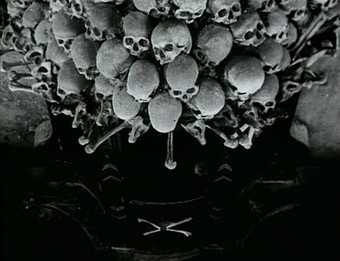
The
Ossuary / Kostnice [1970] (10:06)
A visually startling trip through the Sedlec Ossuary, an
extraordinary Roman Catholic chapel decorated with the bones
of over 40,000 human skeletons, largely victims of the Black
Death in the 14th century. It's the sort of place that even
a straight documentary would render bizarre, but
Svankmajer's approach – all sudden camera movements and
lightning edits – imbues it with a particularly nightmarish
quality, images caught fleetingly that prove cumulatively
overpowering. The
original soundtrack consists of the voice of a female guide
cheerlessly giving a group of schoolchildren a tour of the
Ossuary and becoming increasingly impatient at their inability
to obey the 'don't touch' rule, even imposing an on-the-spot
fine on one unfortunate. It's a fascinating aspect of the
film that both compliments and counterpoints the visuals,
its continuous flow at deliberate odds with the fractured
editing style, but fleetingly in sync with the speech, as
when the guide complains of the graffiti that has been drawn
on the bones is married to the image of a series of skulls bearing the signatures
of past visitors. For reasons known best to
the authorities of the time, this soundtrack was considered
in some way subversive and a new track was commissioned,
a strangely (and intermittently effectively) at-odds piece
of lounge jazz, preceded by a short history of the Ossuary.
Here the editing feels less jarring than on the original
version, due in no small part to our own experience with
the sometimes frantic visuals of music videos, where music
provides a glue that natural sound cannot. Both versions
are included here, and despite the intriguing strangeness
of the music track, I'll go with the original every time.
Jabberwocky
/ Zvahlav aneb Saticky Slameného Huberta
[1971] (13:20)
Taking inspiration from Lewis Carroll's famous nonsense
poem rather than attempting to visualise it, this is an
imaginative tour-de-force that goes some way to defining
what could vaguely be described as the Svankmajer style,
from its realistic figure animation to the use of varied
materials and techniques. It's the sort of film that at
first seems deliberately random in its imagery and yet invites
detailed analysis of every scene, its play on childhood
memories and abstract fears as pure an expression of animated
surrealism as Svankmajer had delivered up to this point
in his career.
Leonardo's
Diary / Leonarduv denik [1972] (11:16)
Svankmajer switches materials again with this rare venture
into traditional 2D drawn animation, but typically combines
it with 3D stop motion to repeatedly crumple the paper on which the
images appear. The drawings here are all based
on Leonardo Da Vinci's own and are beautifully rendered
and animated, the relationship between the animator and
his inspiration established by a pencil that draws a hand
that then takes over the process of creation. The intercutting
of animated historical battles with footage of modern street
riots gives the film a political undercurrent that once
again landed Svankmajer in trouble with the powers that
be, resulting in a seven year absence from the director's
chair.
| the films – disc 2: the later shorts 1979-92 |
|
The
Castle of Otranto / Otrantsky zámek [1979]
(17:15)
The playful humour than runs through much of Svankmajer's
work shifts up a step as reporter Milos Ryba interviews
archaeologist Jaroslav Vosáb about his theories regarding
Horace Walpole's 1764 gothic novel The Castle of Otranto.
The live action mockumentary footage is intercut with sequences
from the novel, brought to life through Terry Gilliam style
cut-out animation of the book's illustrations, complete
with captions and page reference numbers. Typically fast
paced, it builds to a supernatural punchline which the final
shot of Dr. Vosáb appears to amusingly deconstruct.
The
Fall of the House of Usher / Zánik domu Usheru
[1980] (15:02)
The first of Svankmajer's two Edgar Allen Poe adaptations
hooks into the original story's sense of gloom and decay,
the latter a favourite theme of the animator's and one that
becomes the key focus of this richly atmospheric trip through
the Usher house. Beautifully toned monochrome photography
recalls the destructive imagery of Fantasy in G
Minor and The Flat, while a combination
of object manipulation and superb clay animation creepily
evokes the atmosphere of the story without ever showing
any of the human protagonists.
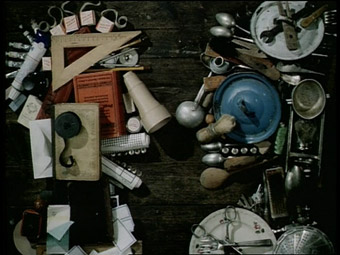
Dimensions
of Dialogue / Moznosti dialogu [1982] (11:18)
One of the most perfectly realised of Svankmajer's short
films, Dimensions of Dialogue is a brilliant
riff on the consequences of humankind's inability to effectively
communicate. The film is divided into three titled sections. The first, Factual Dialogue, is one of the director's most
technically complex pieces, a twist on the Rock-Paper-Scissors
game in which human heads constructed from different everyday
materials (kitchen implements, fruit and vegetables, stationery
items and tools – the practical, the organic and the artistic,
all key elements of modern human existence) are swallowed
by each other, chewed up and spat out to reform from the
damaged material, which then moves on to inflict similar
damage on another. In the second, Passionate Dialogue,
perfectly sculpted clay figures of a man and a woman touch,
kiss, embrace and dissolve into a rippling torrent of sexual
pleasure. When they emerge they have created an offspring,
an unformed clay blob that neither of them want and that
becomes a weapon in their rapidly deteriorating and physically
destructive relationship. In Exhausting Dialogue,
the clay heads of two middle-aged men produce complimentary
objects from their mouths, a sharpener for a pencil, paste
for a toothbrush, laces for a shoe, butter for bread. Their
mutually agreeable dialogue soon falters, however, as the
same objects are mismatched and inflict damage on each other,
leaving both heads crumpled and exhausted. This is surrealism
with purpose, the message always clear but delivered with
a skill and imagination that is genuinely touched by
genius.
Down
to the Cellar / Do pivnice [1983] (14:44)
A young girl is sent down to the cellar of her apartment
block to collect potatoes from the crate in which they are
stored. It's a journey filled with strange terrors, including
a man who sleeps in a bed of coal and offers her rest for
the night, a woman who makes cakes from coal dust, potatoes
that leap from her basket and make their own way back to
their crate, and a giant and fearsome-looking cat. The most clearly
autobiographical of Svankmajer's films is also the one that
that speaks most directly to the childhood fears of its
audience, awakening memories of a time when surrealism was
not just confined to the dream world, but part of imagination-fuelled
everyday life.
The
Pendulum, The Pit and Hope / Kyvadlo, jáma a nadeje
[1983] (14:20)
Svankmajer's second Poe adaptation is a genuinely disturbing
retelling of The Pit and the Pendulum, one that puts
the audience inside the head of the tale's unfortunate protagonist
to create a completely subjective experience. The atmosphere
of twisted horror is heightened by Eva Svankmajerová's
production design and Miloslav Spála's high contrast
monochrome camerawork.
Virile
Games / Muzné hry [1988] (14:01)
A man lines up the beers and the biscuits for the big football
match on TV in which the players win points not for scoring goals
but for fatally and spectacularly assaulting each other.
Clearly a comment on violence in sport and spectator reaction
to it (fans cheers wildly at the match while the viewer
indifferently drinks another beer, even when the
action spills over into his flat). There's nonetheless a wonderfully
perverse humour to the on-pitch ballets, the extended half-time
bathroom break and the grimly creative methods the players
use to dispatch each other, a tit-for-tat battle that you
can't help thinking had at least some influence of Bill
Plympton's 1991 animation Push Comes to Shove.
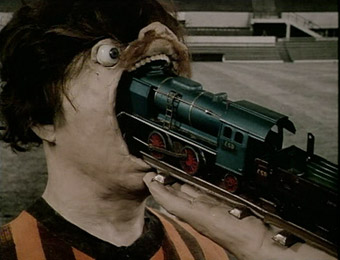
Another
Kind of Love [1988] (3:35)
Another rarity for Svankmajer, a music video for Stranglers'
ex-front man Hugh Cornwell, one that's busy with imagery both
familiar and new, and despite the song's upbeat melody there's
a pleasingly dark sense of a man trapped in a room of his
own memories and fantasies, physical contact with which
results in him being pulled into the wall and out of physical
existence. All that's missing here is an explanation of
how the hell Hugh Cornwell, of all people, was able to persuade
one of the world's greatest animators to illustrate his
song.
Meat
Love [1988] (1:07)
A visual gag in which two steaks cut from a beef joint enjoy
a brief flirt before their intimate roll in the flour lands
them in the frying pan. A subtextual element is nonetheless
evident, and the animation alone is a delight.
Darkness-Light-Darkness
/ Tma/Svetlo/Tma [1989] (7:13)
Various body parts arrive in a small room and innocently
attempt to find a logic to their assembly, alternately curious
and fearful at the arrival of more. Beautifully sculpted
and animated, this is one of Svankmajer's most overtly playful
and wittily comedic films, but it still ends on a note of
claustrophobic, surrealist horror.
Flora
[1989] (0:31)
A body made of vegetable material and tied to a bed is rapidly
decaying, unable to reach the nearby glass of water that
may just save its life. Just thirty seconds long but still
visually startling and packed with subtext about the age,
encroaching decrepitude, and our own role in the cycle of
nature.
The
Death of Stalinism in Bohemia / Konec stalinismu v Cechách [1990] (9.24)
Post-Velvet Revolution Svankmajer dumps the subtle approach
for his most up-front political statement, a self-proclaimed
"work of agitprop" that provides a fragmented
political history of Communist Czechoslovakia. Subtle it ain't
– workers moulded from clay on a production line are
then executed and dumped for recycling; the flag of the
Czech Republic is painted on every every surface in a run-down
workshop; rolling pins crush everything in their
path – but artistically thrilling it most definitely is.
If you don't know your Czech political history then it should
at least prompt a little post-film research.
Food
/ Jídlo [1992] (16:22)
Adopting the three-act structure of Dimensions of
Dialogue, Food is a wonderfully
designed and consistently witty exploration of human consumption,
both literally in the items ingested and metaphorically
in its digs at greed and social division in an increasingly
disposable society. Breakfast is a nightmarish
riff on both the fast food culture (the first McDonald's
restaurant opened in Prague in March of 1992) and humankind's
role in the food chain, with diners feeding
before being transformed into dispensing machines for the next customer.
Snobbery and the new social divisions get a dig in Lunch,
as a sniffy businessman and an unkempt youth repeatedly
fail to attract the attention of a resturant waiter and take to eating the plates, their clothes and even the
furniture, but it isn't destined to stop there. In Dinner,
a large gastronome spends forever adding condiments to a
dish that has been very specially prepared just for him,
a sly dig perhaps at self-destructive modern lifestyles
and eating habits. Technically Food one
of Svankmajer's most impressive achievements to date, the
switch from live action to claymation so perfectly executed
that the join is genuinely invisible. By the way, the bearded
gentleman who sits down for breakfast at the end of the
first sequence is the film's animator Bedrich Glaser.
Svankmajer's aspect ratio of choice has almost always been 1.33:1
and the majority of the films here have thus been so presented,
the notable exception being J.S. Bach – Fantasy
in G Minor, which was shot in scope and has been
anamorphically enhanced for this release. All of the films
are genuine PAL remasters, and despite the age of some and a few
dust spots here and there, this is far and away the best
you've ever seen any of them look, and I'm including Kino's
US Svankmajer short film collections. Sharpness is generally
excellent and colour and contrast are just right, the black
levels always coal-cellar perfect. The tonal beauty of the
greyscale images in the monochrome films is particularly
well captured, the high contrast look of a couple of them
clearly deliberate. Detail is just a tad softer on two or
three of the films (Meat Love is probably
the most noticeable), but the picture quality otherwise
remains high.
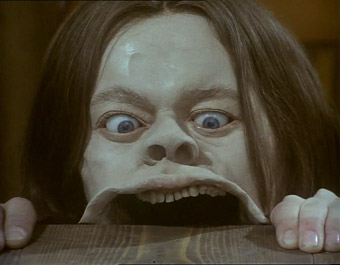
The extra features are also nicely presented, although Johanes
Doktor Faust is non-anamorphic scope and to keep
the picture clear the subtitles are in the border area.
This should cause no problems on LCD and plasma TVs, but
depending on the overscan of your CRT widescreen you may
lose a little information when there are two lines of text,
unless you have a subtitle zoom mode. Otherwise the picture
quality is fine. The Lunacy trailer is
anamorphically enhanced widescreen.
The
soundtracks are largely Dolby 2.0 mono and always clear
– a little fluff and crackle is audible on Down
to the Cellar, there's a bit of a hum on Johanes
Doktor Faust, and there are a couple of pops on
the soundtrack of The Castle of Otranto.
Food has a very nice stereo track, and
both the Chez TV interview and the Lunacy
trailer are also in stereo.
Johanes
Doktor Faust [1958] (17:23)
Directed by Emil Radok, this is the first film that has
Svankmajer's name in its credits and one he remains proud
of. A retelling of the Faust story with puppets "made
by an old family of puppeteers," it foreshadows Svankmajer's
own work with its smart use of camera angles and movements,
its effective mixing of animation styles, its sometimes
unsettling dreamlike imagery and its excellent montage work.
Svankmajer, of course, was later to make his own version
of Faust in 1994.
Nick
Carter in Prague / Adéla jeste nevecerela
[1977] (5:00)
Three extracts from a longer work made during the post-Leonardo's
Diary period when Svankmajer abandoned directing
and worked instead on other people's films, here creating
a giant carnivorous plant that would not be out of place
in The Little Shop of Horrors.
The
Cabinet of Jan Svankmajer [1984] (53:36)
A documentary directed for Channel 4 on Svankmajer by the
Quay Brothers' regular producer Keith Griffiths, with animated
inserts from the Quays that were compiled into a short film for
inclusion on the BFI's Quay
Brothers Short Films DVD. Here those same sequences
are beguilingly used in place of interviews that Svankmajer
was apparently unwilling to give, cut with extracts from
his films (almost all of Dimensions of Dialogue
is included) and interviews with a number of art historians,
surrealists and critics. Animated links and revealing quotes
from Svankmajer aside, this is a slightly academic affair,
thanks in part the middle-class dryness of the interviewees
– they know their stuff, but I wouldn't want to be stuck
in a lift with any of them.
Les
Chimères de Svankmajer [2001] (58:18)
Shot during the making of the feature film Little
Otik and the creation of the 1998 touring exhibition
Anima Animus Animation, this is an enthralling and revealing
peek at the creative partnership between Svankmajer and
his wife Eva Svankmajerová. Both appear comfortable
with the camera's presence and talk freely about their past
and present work, and there are some priceless comments here, from Jan's determination to convince young people
that there's more to surrealism than the paintings of Salvador
Dali (ah yes, well...) and his recollection of his childhood
terror of cellars, to Eva's observation that ten years after
the fall of communism they are all now encouraged to be
only interested in money, which is just as bad. The behind-the-scenes
material on Little Otik is particularly
welcome. Terrific.
Czech TV Interview (2001) (8:58)
A brief interview conducted with Svankmajer as part of a
Czech TV series The History of Painting and Sculpture that includes some of his artwork and a useful overview
of Eva Svankmajerová's paintings. I was particularly
caught by Svankmajer's assertion that the common denominator
to what he does in his work is "the game."
'Lunacy'
Trailer [2005] (3:04)
A trailer that leaves you wondering just what the film
as a whole must play like, but that intrigues nonetheless.
Booklet
The
final extra is not on any of the discs, but takes the form
of a handsomely produced booklet containing a number of
quality stills and an informative essay on every film and
extra in the set.
What
can I say? A genuinely remarkable body of work, all splendidly
remastered and collected together in a wonderfully comprehensive
3-disc set. Even if you have a substantial number of these
films on other formats or even DVD, this is a must-have,
and if you are seriously interested in either animation
or surrealism or both, then consider this an essential purchase.
Absolutely bloody marvellous.
|